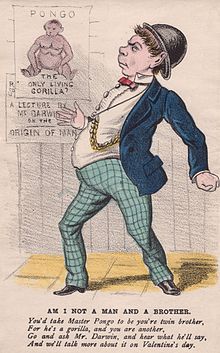M'Pungu
M'Pungu (* 1874 in Portuguese Congo ; † November 13, 1877 in Berlin ) was the second gorilla to reach Europe alive. From July 1876, it was put on public display in the Berlin Aquarium Unter den Linden . Since anatomical and behavioral studies could be carried out on a living gorilla for the first time outside of Africa , the animal was also perceived as a sensation by zoologists . The first gorilla to reach Europe alive, a young female ("Jenny"), was displayed in girls' clothes for seven months in England by Wombwell's Traveling Menagerie in 1855/56 , but was mistaken for a chimpanzee .
“M'Pungu” was the general name for all gorillas in the language of the Africans living near the coast in the area of today's Zaire .
Life

M'Pungu, also known as Master Pongo or Pongo for short , a young male gorilla, was given as a gift to the German doctor Julius Falkenstein by the Portuguese Laurentio Antonio dos Santos on October 2, 1875 , who had been in the then Portuguese colony since the beginning of 1874. Congo - in the Chinchoxo trading post - and dos Santos had repeatedly given medical attention. Julius Falkenstein was part of a research group known as the Loango Expedition , which was based around 90 kilometers north of the Congo estuary on the initiative of the German Society for Research into Equatorial Africa, founded in 1873 . M'Pungu had been captured by an African hunter in the hinterland and sold to the Portuguese; the animal was estimated to be 14 months old at this point.
After the initially severely weakened young animal recovered in the trading station, Falkenstein and the M'Pungu he looked after like a toddler went on board a post ship in May 1876 and traveled via Liverpool and Hamburg to Berlin, where they arrived on June 30, 1876. The following day the gorilla was brought to the Unter den Linden aquarium and, after a short period of acclimatization, was put on display with great interest from the public. In the following months it was studied in detail at the Berlin Aquarium by Robert Hartmann , Arthur Kollmann , Karl Freytag and Wilhelm Peters, among others . Initially, the gorilla was housed in an existing cage together with baboons and monkeys , but from the end of August 1876 in a newly furnished, more spacious cage that was connected to a small palm house.
From mid-July to early September 1877, M'Pungu was exhibited at the Royal Aquarium in London . As before in Berlin, the gorilla was visited by numerous naturalists in London , including Richard Owen , St. George Mivart and Frank Buckland . It also met with great public interest in general, as can be seen from numerous contemporary press articles; the London Times featured the arrival of the great ape on its front page, and even The New York Times and newspapers in Australia and New Zealand reported. In August 1877, the satirical magazine Punch published a dozen line long poem (“Reflections on the Gorilla at the Aquarium”) with ancient sprinkles (“doth” instead of “does”) about:
- "Master Pongo, from the Congo
- Or, more strictly, the Gaboon stream -
- Sole gorilla
- That doth fill a
- Place beneath pale Europe's moon-stream […]. "
death
Without any noticeable omens, M'Pungu died on November 13, 1877 at half past four in the morning. A day later, his carcass was dissected in the presence of Julius Falkenstein and Rudolf Virchow . The cause of death was initially found to be diarrhea and inflammation of the intestines, but five weeks later a "lung affection" ( tuberculosis ) was published. The death of the now internationally known gorilla was reported in numerous newspapers and magazines, for example on December 8, 1877 in the British Medical Journal ; its Berlin correspondent had a few weeks before his readers about his experience with the animal during a private audience ( "private audience by the Gorilla") informs.
In 1890 a laconic obituary appeared in the third edition of Brehms Tierleben (Volume 1, p. 71) , with the content that “it was at least no longer a loss for science. What could be observed about him could be seen abundantly, and his body also gave the opportunity to study all organs down to the finest details. "
The skeleton of the young gorilla is said to have been kept in the Berlin Museum of Natural History , but is now considered lost there.
literature
- Mustafa Haikal : Master Pongo. A gorilla conquers Europe. Transit Buchverlag, Berlin 2013, ISBN 978-3-88747-285-6
Web links
- Pongo's story. The first gorilla in Germany - a sensation. On: welt.de , March 17, 2013
- History of an African trophy. On: dradio.de , April 4, 2013
- Drawings of M'Pungu in various positions. Made from photographs, published a. a. in The Royal Natural History Volume 1 , London 1893-1894, edited by Richard Lydekker. From: flickr.com , accessed September 3, 2015
Individual evidence
- ↑ Mustafa Haikal: Master Pongo. A gorilla conquers Europe. Transit Buchverlag, Berlin 2013, p. 23, ISBN 978-3-88747-285-6 .
- ↑ Today, Pongo refers to the genus of orangutans
- ↑ Mustafa Haikal: Master Pongo , p. 45
- ↑ Mustafa Haikal: Master Pongo , p. 92 ff.
- ↑ Mustafa Haikal: Master Pongo, p. 103
- ^ Death of the Gorilla in Berlin. In: British Medical Journal. Volume 2, 1877, p. 814, doi: 10.1136 / bmj.2.884.814
- ^ British Medical Journal. Volume 1, 1877, p. 456
- ↑ Quoted from Hans Werner Ingensiep: The cultivated monkey. Philosophy, history, present. S. Hirzel, Stuttgart 2013, p. 171, ISBN 978-3-7776-2149-4
- ↑ # 137 Zoo Stories: Get into the Enclosure. Radio broadcast on Deutschlandfunk Nova on July 7, 2017 (from minute 62:30)

